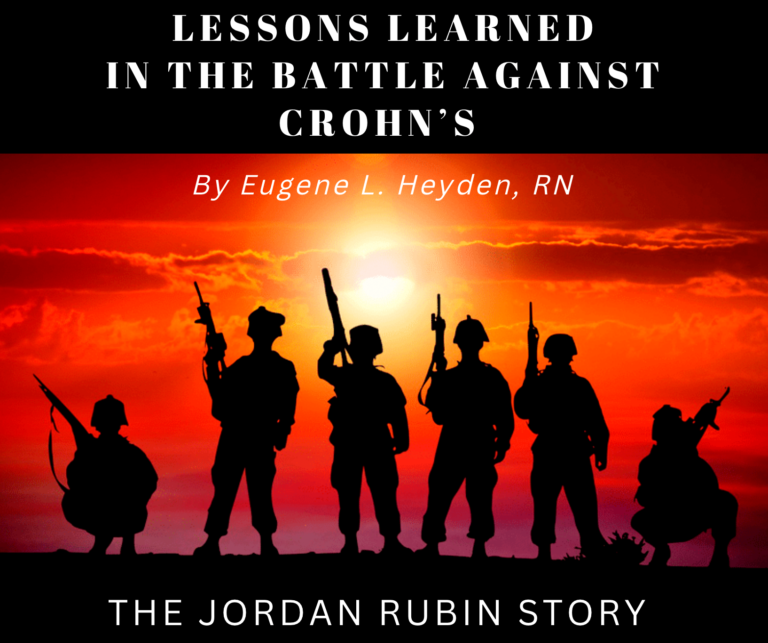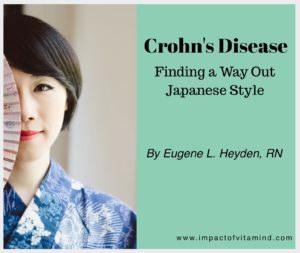The Jordan Rubin Story

Last update: 06-14-23
By Eugene L. Heyden, RN
“When I released The Maker’s Diet in 2004, two things happened that I never expected. One, I could never have imagined in my wildest dreams that The Maker’s Diet would become one of those word-of-mouth publishing phenomena that would propel the book to the New York Times best-seller list (in the health category) for forty-seven weeks in 2004 and 2005, with two million copies in print. The overnight success of the Maker’s Diet led to appearances on Good Morning America, NBC Nightly News, FOX News, Inside Edition, and interviews with Time, Newsweek, the New York Times, Reader’s Digest, and People magazine, as well as hundreds of radio stations.” ~Rubin, 2008
Why the medical community did not learn from the experience of Jordan Rubin—analyze it to death and develop a protocol—is beyond me. In the medical literature there may be a mention or two of The Maker’s Diet in passing, but it appears that no one in the medical community took seriously Jordan Rubin and the diet he created. But that won’t stop me! And based on the success that can be achieved by diet, as we have seen in the case reports previously discussed, I think the medical community owes Jordan a little apology.
But before we get to Jordan’s case report, I would first like you to meet him. You can actually do this (sort of), by typing his name in Google and taking it from there. If you go to Images in Google, under his name you will see the before and after pictures. Should you do this, you are allowed to be impressed (or blown away). So, how did he transform himself from one so gravely ill and profoundly malnourished to the picture of health plus health? Let’s see . . .
Case report: Jordan Rubin
At age 19, Jordan Rubin was a healthy, athletic college student, but during this period in life he became quite ill, experiencing diarrhea the likes of which no one should ever experience (or wish on their worst enemy), and which resulted in a 20-pound weight loss over a period of a week.
Although not sure what was wrong, Jordan’s doctor prescribed a course of antibiotics and back to school Jordan went . . . only to become progressively more ill. By “more ill,” I mean “12 to 30 bowel movements, mostly bloody” per day, along with episodes of intense abdominal pain. Weight loss continued.
Soon, it became clear that Jordan was suffering from Crohn’s disease. And when you suffer from Crohn’s disease, you go to the doctor. And when you go to the doctor, the doctor gives you drugs. And when the doctor gives you drugs, you get better or you don’t. Jordan did not get better, not even close—and tried everything that the medical establishment had to offer, and I mean everything! His health deteriorated despite all that was done on his behalf. At its worst, Jordan had lost a total of 81 pounds and had become so weak that he was fitted for a wheelchair. He looked like death warmed over, and that would have been a compliment. He certainly could have died from his illness. (Can you relate to any of this?)
In a personal crusade to find answers and turn things around, Jordan and his father (who was a naturopathic physician), traveled to seven different countries, visiting anyone who could provide answers and relief, but to no avail. Although he tried numerous therapies, nothing worked, and Jordan remained ill. But this would all change.
Near the end of what was a two-year journey to regain health and beat his disease, a nutritionist was consulted, and the rest is history. The nutritionist recommended a whole foods diet, patterned after the diet of ancient biblical times—lean and “clean” meats (no pork, shellfish, crab or lobster, nor animals or life forms that play the role of a scavenger) and naturally-grown fruits and vegetables. Processed foods were to be avoided. That’s pretty much it! Willing to try anything and avoid anything, Jordan began following the new diet. In a book recounting his experience, Jordan describes his diet:
“My ‘biblical’ diet consisted of kefir—’naturally fermented milk’ from raw goat’s and cow’s milk; organically raised, free-range, or grass-fed meats; and eggs and meat from healthy chickens. It also included ocean-caught wild fish and natural sprouted or sourdough breads made from yeast-free whole grains, as well as raw nuts and seeds, organic fruits and vegetables, raw sauerkraut, and carrot and other vegetable juices.” (Rubin, 2005)
At the beginning of the new diet, Jordan did not feel great. In fact, he felt a little worse, but did not waver. Believing he was on the right track, Jordan continued the diet and traveled from his home in Florida to California to be close to the nutritionist whose theories he was putting to the test. Needless to say, Jordan was glad he did.
Within a month after arriving in California, and by following the new diet, Jordan had gained 20 pounds as symptoms slowly melted away. At the 90-day mark, Jordan had regained most of the 81 pounds he had lost and was the picture of health. He had beat Crohn’s! But perhaps not by diet alone.
While in California, and during the time Jordan was beginning to achieve some success with diet, his father sent him a new probiotic to try. But not just any probiotic. The probiotic was comprised of soil organisms, organisms believed to have once been abundant in the gut, but less so due to modern farming practices, food processing techniques, and due to reduced exposure to dirt by the “modern” individual. This may seem like a strange thing to do (like, to eat dirt), but there is some science behind the use of this type of probiotic. Soil organisms have been our faithful companions throughout the ages, continually seeding the gut with useful organisms that compete with other bacteria, including harmful bacteria, for space and for nutrients. And apparently, soil organisms have a positive impact on the gut. Consider the following:
“Hygiene is also a risk factor for IBD. IBD is more common in urban versus rural areas and less common in people who have jobs exposing them to dirt.” (Weinstock et al., 2004)
“Specific components of soils, if assimilated into the tissues via ingestion of plant or animal food or drinking water, could possibly strengthen host defenses against infection.” (Weinberg, 1987)
“Several changes in life-style are associated with this transition [the decrease in infectious diseases and the emergence of inflammatory diseases], including diminished exposure to soil and animals, nutritional bias, obesity and increased exposure to pollution and antibiotics, which all impact the intestinal microbiota.” (Ehlers and Kaufmann, 2010)
“People with blue collar jobs exposing them to dirt and physical exercise are less prone to IBD.” (Weinstock et al., 2004)
Not to discount the power of probiotics, I tend to believe that the recovery Jordan experienced was primarily due to diet rather than due to the use of soil probiotics. I believe this because I personally know Adam Dunlap. (Case report below.)
Note: From his experience in defeating Crohn’s, Jordan went on to develop what is called The Maker’s Diet and began marketing soil organisms to help others regain their health, in view with his accomplishment. Jordan Rubin tells his story in the following two books. His story can also be found in other books, various articles on the internet, as well as in videos available on YouTube.
Related posts: (Click image to view)
References:
Rubin J. The Maker’s Diet. Charisma Media; 2005
Rubin J. The Maker’s Diet for Weight Loss. Charisma Media; 2008 Dec 8.
DISCLAIMER: This article is offered solely for informational purposes. The information contained therein and opinions expressed should be evaluated for accuracy and validity in the context of opposing data, new information, and the views and recommendations of a qualified health care professional, and not to be substituted for professional judgment and guidance or to provide a reason to neglect or delay appropriate medical care for self or for others. It is the reader and reader only who bears the responsibility for any actions that could be construed as being a response to the information presented. The statements and opinions expressed by the author have not been reviewed or approved by the FDA or by any other authoritative body, nor is the author endorsing any product or specific therapy mentioned. This article and the opinions contained therein are offered to the reader to broaden his or her understanding of the issues discussed and to help identify options that may be suitable for the individual to pursue, on behalf of self or others, under approval and direction of a qualified physician or medical team member. All questions of a medical nature which arise from reading this article should be directed at qualified health care professional. There are no guarantees that a suggested website and internal links are safe to visit or open or are currently available.
Copyright © 2023 Eugene L. Heyden, RN
All Rights Reserved




